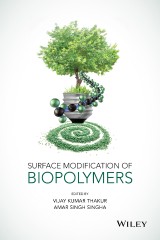Details

Surface Modification of Biopolymers
1. Aufl.
|
CHF 140.00 |
|
| Verlag: | Wiley |
| Format: | |
| Veröffentl.: | 26.05.2015 |
| ISBN/EAN: | 9781119044772 |
| Sprache: | englisch |
| Anzahl Seiten: | 448 |
DRM-geschütztes eBook, Sie benötigen z.B. Adobe Digital Editions und eine Adobe ID zum Lesen.
Beschreibungen
<p>This book addresses surface modification techniques, which are critical for tailoring and broadening the applications of naturally occurring biopolymers. Biopolymers represent a sustainable solution to the need for new materials in the auto, waste removal, biomedical device, building material, defense, and paper industries.<br /><br />Features:<br /><br /></p> <ul> <li>First comprehensive summary of biopolymer modification methods to enhance compatibility, flexibility, enhanced physicochemical properties, thermal stability, impact response, and rigidity, among others</li> <li>Address of a green, eco-friendly materials that is increasing in use, underscoring the roles of material scientists in the future of new "green" bioolymer material use</li> <li>Coverage applications in automotive development, hazardous waste removal, biomedical engineering, pulp and paper industries, development of new building materials, and defense-related technologies</li> <li>Facilitation of technology transfer</li> </ul>
<p>List of Contributors vii</p> <p>Preface xi</p> <p>1 Surface Modification of Biopolymers: An Overview 1<br /><i>Manju Kumari Thakur, Ashvinder Kumar Rana, Yang Liping, Amar Singh Singha, and Vijay Kumar Thakur</i></p> <p>2 Surface Modification of Chitosan and its Implications in Tissue Engineering and Drug Delivery 20<br /><i>Dilip Depan and Raj Pal Singh</i></p> <p>3 Microwave‐Irradiated Synthesis of Agar‐Based Graft Copolymers: Analytical Evidences, Biomedical and Environmental Applications 45<br /><i>Sumit Mishra, Gautam Sen, and G. Usha Rani</i></p> <p>4 Adaptation of Biopolymers to Specific Applications 84<br /><i>Cecilia I. Alvarez Igarzabal, Marisa Martinelli,Verónica Brunetti, and Miriam C. Strumia</i></p> <p>5 Modifications of Lignocellulose Fibers and its Application in Adsorption of Heavy Metals from Aqueous Solution 113<br /><i>Vicente de Oliveira Sousa Neto, Francisco Cláudio de Freitas Barros, Diego de Quadros Melo, Paulo de Tarso C. Freire, Marcos Antônio Araujo‐Silva, and Ronaldo Ferreira do Nascimento</i></p> <p>6 Tailoring Surface Properties of Degradable Poly(3‐Hydroxyalkanoates) for Biological Applications 150<br /><i>Estelle Renard, Davy‐Louis Versace, Julien Babinot, and Valerie Langlois</i></p> <p>7 Physically and Chemically Modified Starches in Food and Non‐Food Industries 173<br /><i>Małgorzata Kapelko‐Żeberska, Tomasz Zięba, and Akhilesh Vikram Singh</i></p> <p>8 Polymer Modifications and Recent Technological Advances toward Live Cell Encapsulation and Delivery 194<br /><i>Paulomi Ghosh, Kausik Kapat, and Santanu Dhara</i></p> <p>9 Surface Modification of Natural Fibers for Reinforcement in Polymeric Composites 224<br /><i>Na Lu, Shubhashini Oza, and Morteza Ghaempanah Tajabadi</i></p> <p>10 Surface Electroconductive Modification of Biopolymers 238<br /><i>Hamidreza Barghi and Mohammad J. Taherzadeh</i></p> <p>11 Surface Modification of Cellulose Nanocrystals for Nanocomposites 258<br /><i>Jin Huang,, Youli Chen, and Peter R. Chang,</i></p> <p>12 Biopolymer‐Based Stimuli‐Sensitive Functionalized Graft Copolymers as Controlled Drug Delivery Systems 291<br /><i>T.S. Anirudhan and S.R. Rejeena</i></p> <p>13 Nucleophile‐Induced Shift of Surface Plasmon Resonance and its Implication in Chemistry 335<br /><i>Anindita Roy and Tarasankar Pal</i></p> <p>14 Surface Modification of Natural Fiber Composites and their Potential Applications 370<br /><i>Moshibudi C. Khoathane, Emmanuel R. Sadiku, Chinenyeze S. Agwuncha</i></p> <p>15 Effect of Surface Modification of Natural Cellulosic Fibers on the Dielectric and Mechanical Properties of Polymer Composites 401<br /><i>Ashvinder Kumar Rana, Amar Singh Singha, Manju Kumari Thakur, and Vijay Kumar Thakur</i></p> <p>Index 419</p>
<b>Vijay Kumar Thakur</b>, PhD, is Staff Scientist in the School of Mechanical and Materials Engineering at Washington State University. His former appointments include being a research scientist in Temasek Laboratories at Nanyang Technological University, Singapore, and a visiting research fellow in the Department of Chemical and Materials Engineering at LHU-Taiwan. In his academic career, he has published more than 78 SCI journal research articles in the field of polymers/materials science and holds one United States patent. He has also published 10 books and 25 five book chapters on the advanced state-of-the-art of polymers/materials science with numerous publishers. In addition to being on the editorial board of journals, he also serves as the Guest Editor of “Journal of Nanomaterials”, “International Journal of Polymer Science”, “Journal of Chemistry" and “American Journal of Applied Chemistry”.<br /> <br /> <b>Amar Singh Singha,</b> PhD, is Professor of Polymer Chemistry of the Chemistry Department at the National Institute of Technology – Hamirpur (H.P.) India. He received his M.Sc., M. Phil. and Ph.D. in Organic Chemistry from the Himachal Pradesh University Shimla (India), in 1983. Dr. Singha serves on the Editorial Board of International Journal of Polymer Analysis and Characterization (Taylor & Francis), BioResources and ISST Journal of Applied Chemistry. He is the author of more than 200 international research publications, 6 books and has a number of book chapters to his credits.
<p><b>Addresses surface modification techniques, which are critical for tailoring and broadening the applications of naturally occurring biopolymers<br /><br /></b>Biopolymers represent a sustainable solution to the need for new materials in the auto, waste removal, biomedical device, building material, defense, and paper industries. Despite this eco-friendly advantage, the need for improvements and desired properties of biopolymers continue. Research centered on the fundamentals and applications have led to the concept of altering characteristics to obtain biopolymers of optimal and desired properties. The kinds of techniques utilized in such practice are presented in <b><i>Surface Modification of Biopolymers</i></b>. Clear and comprehensive, the text features:<br /><br /></p> <ul> <li>The first comprehensive summary of biopolymer modification methods to enhance compatibility, flexibility, enhanced physicochemical properties, thermal stability, impact response, and rigidity, among others</li> <li>Summaries of numerous significant advances in the surface modification routes for the functionalization of biopolymers starting from cellulose to starch, as well as main challenges for the facile functionalization of the different biopolymers</li> <li>Coverage of applications in automotive development, hazardous waste removal, biomedical engineering, pulp and paper industries, development of new building materials, and defense-related technologies</li> </ul> <br />Critical issues and suggestions for future research avenues are discussed, underscoring the roles of materials scientists and researchers for the future of these new "green" materials. This book is useful for multidisciplinary undergraduate and postgraduate students, materials and biomaterials scientists and engineers, polymer chemists, biochemists, and biotechnologists.

















